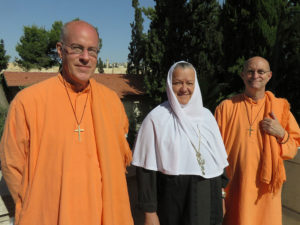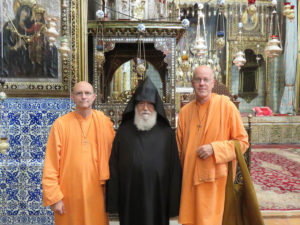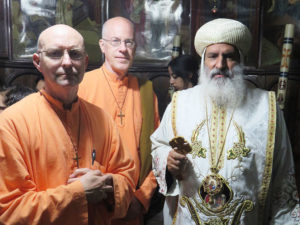The second of five blog posts about our recent pilgrimage to the Holy Land (see part 1 here)
PART 2—The Two Marys
Note: to see the images in this post full size in a new tab, simply click any image.
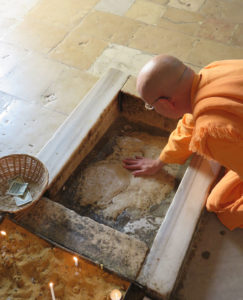 The next day we made our first visit to the Mount of Olives, site of so many important churches and shrines. Visiting the Russian Church of the Ascension near the top of the Mount, we discovered the chapel that marks the spot where Saint John the Baptist was beheaded. Making our way down the Mount we next visited the small shrine of the Ascension. Under Muslim jurisdiction, the small domed building contains no icons, altar, or other signs of Christian worship. In the center of the floor is the Ascension rock marking the spot from which Christ ascended into the heavens. When we knelt to venerate the rock we could see for ourselves the clear impression of Jesus’ right foot in the stone. We learned that the section with the left footprint had been taken to the Al-Aqsa Mosque in the Middle Ages.
The next day we made our first visit to the Mount of Olives, site of so many important churches and shrines. Visiting the Russian Church of the Ascension near the top of the Mount, we discovered the chapel that marks the spot where Saint John the Baptist was beheaded. Making our way down the Mount we next visited the small shrine of the Ascension. Under Muslim jurisdiction, the small domed building contains no icons, altar, or other signs of Christian worship. In the center of the floor is the Ascension rock marking the spot from which Christ ascended into the heavens. When we knelt to venerate the rock we could see for ourselves the clear impression of Jesus’ right foot in the stone. We learned that the section with the left footprint had been taken to the Al-Aqsa Mosque in the Middle Ages.
“Christ is Risen!”
We greeted a group of Romanian pilgrims following the same route down the Mount of Olives with these words of Paschal greeting, and they gave us the traditional response: “Truly He is risen!” Orthodox Christians exchange this greeting during the forty days after Easter. It is wise for the pilgrim traveling at this time to know it in Russian, Greek, and Romanian. Many times during our trip we saw how this paschal greeting could change us from strangers to brothers in an instant. This time it was an occasion for questions, happy greetings, a photo op, and the gift of a peach from one of the pilgrims.
Many attribute the origin of this greeting to Saint Mary Magdalen. After the Ascension, she travelled to Rome to meet the Emperor Tiberias. Since no one was allowed an audience with the Roman Emperor who did not bring him a gift, she brought an egg, which she handed to him saying: “Christ is risen!” He was offended at such a lowly gift, but she explained that just as a living thing could eventually emerge from the stonelike shell of the egg, so Jesus came forth from the tomb alive, having been dead when placed there. When he expressed disbelief, the egg turned red as a sign of the truth of the resurrection–and then he believed. From this comes the custom of the Easter Egg; and every Easter (Pascha) the Byzantine Orthodox Christians give one another red-dyed eggs with the Easter Greeting: “Christ is Risen!”
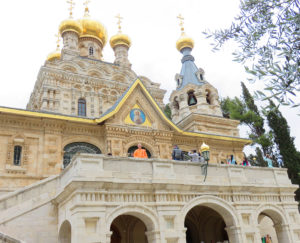 This historic meeting is commemorated in a twenty-foot-tall mural displayed above the sanctuary at our next stop along the slopes of the Mount of Olives, the Church of Saint Mary Magdalen. Built in 1888 by Tsar Alexander III, the gilded domes of the church are an unmistakable landmark on the slopes of the Mount of Olives.
This historic meeting is commemorated in a twenty-foot-tall mural displayed above the sanctuary at our next stop along the slopes of the Mount of Olives, the Church of Saint Mary Magdalen. Built in 1888 by Tsar Alexander III, the gilded domes of the church are an unmistakable landmark on the slopes of the Mount of Olives.
Passing through the gate of the well-kept grounds, we entered a unique atmosphere that would become familiar to us when we encountered it in other Russian churches in Jerusalem: serene, orderly, and pure. A nun stood at the back reciting prayers and hymns from a service book, as is the common practice throughout the day in these churches. Their atmosphere is always especially holy and the mind easily becomes quiet and attentive.
The great treasures of this church are the bodies of the holy martyrs Grand Duchess Elizabeth and her companion the Nun Barbara, reverently displayed for veneration in glass-topped stone sarcophagi. In 1888 Saint Elizabeth attended the consecration of the church as a representative of the Royal Family. Admiring the beauty of the church and the serenity of the Holy Land, she exclaimed, “Oh, how I would like to be buried here.”
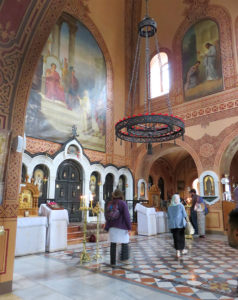 Years later when the revolution came Saint Elizabeth (now an abbess) was imprisoned by the Bolsheviks, and she and Sister Barbara were thrown while still alive into a mine shift, where they sang hymns to each other as their lives slowly ended. Their holy relics were smuggled out of Russia, through China, and eventually brought to this church, thus fulfilling Saint Elizabeth’s desire.
Years later when the revolution came Saint Elizabeth (now an abbess) was imprisoned by the Bolsheviks, and she and Sister Barbara were thrown while still alive into a mine shift, where they sang hymns to each other as their lives slowly ended. Their holy relics were smuggled out of Russia, through China, and eventually brought to this church, thus fulfilling Saint Elizabeth’s desire.
Father Pierre, a convert to Russian Orthodoxy, led our tour of the Convent grounds, which included a cave which Jesus, the Virgin Mary, and the Apostles frequented for prayer, and nearby a large stone marking the spot where the Mother of God appeared to Saint Thomas the Apostle after her Dormition, with a wall adorned with a Byzantine mosaic icon of the event.
Another Life-Giving Tomb
After a short visit to the Garden of Gethsemane, we arrived at the foot of the Mount of Olives and discovered what we would come to appreciate as one of the greatest jewels of the Holy Land: the shrine of the Tomb of the Virgin Mary. The large crypt containing her empty tomb in the Church of the Assumption was built in the fifth century. 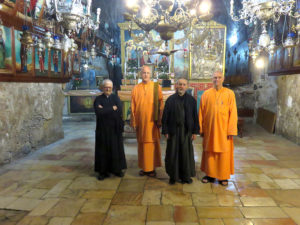 When we descended the steps to the shrine, we found ourselves amidst three liturgies, celebrated simultaneously on the three altars belonging to the Orthodox Churches who claim custody of the shrine: the Armenians, the Copts, and the Syrians.
When we descended the steps to the shrine, we found ourselves amidst three liturgies, celebrated simultaneously on the three altars belonging to the Orthodox Churches who claim custody of the shrine: the Armenians, the Copts, and the Syrians.
The empty stone sarcophagus of the Virgin lies in a small stone “house” directly behind the Armenian altar. Much like the Holy Sepulchre, the narrow tomb only admits about three pilgrims at a time. And the resemblance is spiritual as well as physical. Here was another site where we quietly touched the hem of Someone much greater than we could imagine. We were to return here several times.
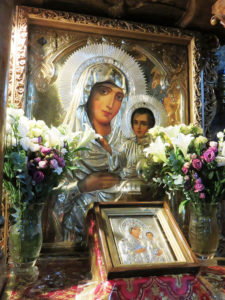 Behind the tomb the silver-covered icon of Our Lady of Jerusalem is enthroned in a large shrine. Throughout the morning pilgrims silently venerated her, and sat on the benches that lined the room to quietly adore and “listen.”
Behind the tomb the silver-covered icon of Our Lady of Jerusalem is enthroned in a large shrine. Throughout the morning pilgrims silently venerated her, and sat on the benches that lined the room to quietly adore and “listen.”
Making a closer examination of the shrine we found the other tombs we had read about. About halfway down the steps we found two niches: on one side, the tomb of Saint Joseph, on the other the tomb of the Virgin Mary’s parents Saints Joachim and Anna.
All roads lead to Jerusalem
One of the most important and joyous elements of pilgrimage are…pilgrims! We enjoyed an instant recognition and easy camaraderie with each other. In no other spot (except in India) have we seen so many of “the Godward,” as Brother Simeon (and earlier, Guru Nanak) puts it. We had gathered here from all over the world, putting aside our obligations and worldly involvements to come here to focus on the most important thing in life: to worship and to wonder. We were all happy to be here, and happy to see each other.
This unspoken bond of friendship makes for an easy familiarity. Mexican pilgrims smilingly addressed “the orange monks” in Spanish as we passed by them in the court before the Virgin’s Tomb. Fortunately I remembered enough of my school-days Spanish to exchange greetings and explain ourselves. Minutes later we were noticed by a party of elderly Muslim women from Nazareth, who followed after us to take hold of our hands and smile, and pose together for a photo.
One day at the Holy Sepulchre we exchanged greetings with a Catholic priest who taught theology in a university at Krakow, and who told us he had made over eighty pilgrimages to the Holy Land over the last thirty-some years(!). Later that visit a man from an Argentinian pilgrim group came over to inquire about us, and to introduce to us the queen of their band, a 90-year-old woman.
Orthodoxy in the Holy Land
It is easy to think of the Holy Land as religiously homogenous – a “lump” of living history, where Jesus, the Virgin Mary, the Apostles and countless saints lived and moved and left the mark of their great blessing upon the land. But the reality is quite different, for there are many distinctions and divisions.
Many of the holy sites have two churches there, one Catholic and one Orthodox, each claiming to contain the true location of the event honored there. We found that there was more credibility to the Orthodox claims in almost every spot. The Orthodox Christians have been in the Holy Land centuries longer than the Catholics, and their claims of authenticity get added weight from what you experience in their churches. Plainly put, it just feels like “This is the spot,” and consequently we always felt a greater blessing in these shrines. Of course, you can make your own judgement on this if you are fortunate to make a pilgrimage there.
Because of our years of experience in Orthodox Christianity, Brother Simeon and I were generally received in a friendly way in the Orthodox sites we frequented, once we got past the initial “What am I looking at?” response to our un-Orthodox appearance. We find it natural to speak the language of Orthodoxy, whether it is the Orthodox way to make the sign of the Cross or venerate icons (or just the fact that one does these things), and we know the saints and history of each of the Orthodox Churches that have had a presence in the Holy Land since the earliest centuries: Armenian, Coptic, Russian, Syrian, and Greek. Because of all this, and also I think because of people’s intuitive assessment of us, we enjoyed a familiarity with the priests, monks and nuns that made our pilgrimage that much more enriching and a real pleasure.
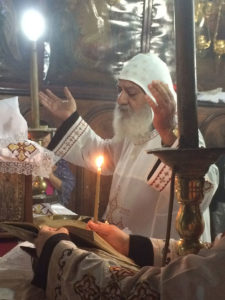 We were given permission to attend the Liturgy at the Church of Saint Mary Magdalen on the Mount of Olives, and afterwards were guests for breakfast and a conversation with the Australian-born Abbess Elizabeth. At the Coptic Convent of Saint Mary in Bethlehem we were also welcomed at the Liturgy celebrated by Bishops Theodosius and Boutros in the underground grotto chapel, and again were invited for breakfast. Bishop Theodosius spoke about an apparition of the Virgin Mary in his diocese at Waraq, where she appeared in the church for twenty-one days and was seen (and filmed) by many people. After afternoon vespers at the Armenian Cathedral of Saint James, we became fast friends with Bishop Sevan, who bestowed his blessing and an episcopal hug. On another occasion we were granted access to the closed upper levels of the Armenian section of the Church of the Holy Sepulchre, where we enjoyed a long conversation with Father Vazgen, who shared stories of his sixteen years of experience in Jerusalem, as we looked down from the high balcony upon the central shrine of the Holy Tomb.
We were given permission to attend the Liturgy at the Church of Saint Mary Magdalen on the Mount of Olives, and afterwards were guests for breakfast and a conversation with the Australian-born Abbess Elizabeth. At the Coptic Convent of Saint Mary in Bethlehem we were also welcomed at the Liturgy celebrated by Bishops Theodosius and Boutros in the underground grotto chapel, and again were invited for breakfast. Bishop Theodosius spoke about an apparition of the Virgin Mary in his diocese at Waraq, where she appeared in the church for twenty-one days and was seen (and filmed) by many people. After afternoon vespers at the Armenian Cathedral of Saint James, we became fast friends with Bishop Sevan, who bestowed his blessing and an episcopal hug. On another occasion we were granted access to the closed upper levels of the Armenian section of the Church of the Holy Sepulchre, where we enjoyed a long conversation with Father Vazgen, who shared stories of his sixteen years of experience in Jerusalem, as we looked down from the high balcony upon the central shrine of the Holy Tomb.
Next: We discover ancient Christianity in the Judean Desert
Previously: Two Monks Discover the Holy Land








